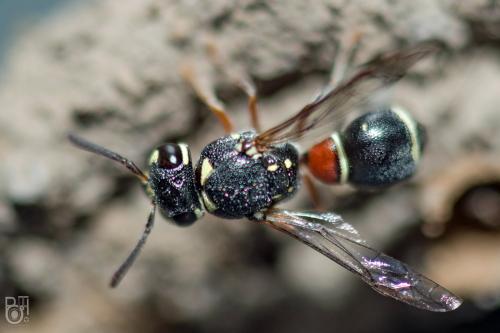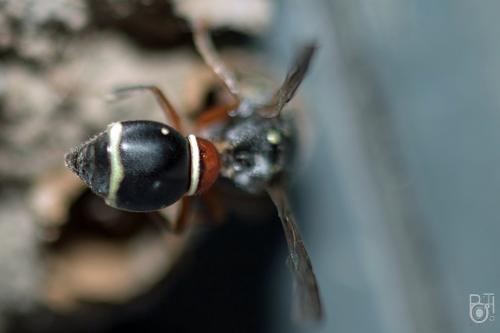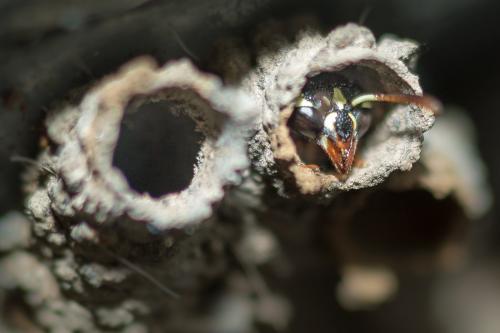Paraleptomenes miniatus miniatus (Saussure, 1885)
Odynerus miniatus miniatus Saussure, 1855.
Et. Fam. Vesp. 3: 249 (in division Parodynerus).
Paraleptomenes miniatus miniatus Soika, 1994.
Ann. Mus. Civ. St. Nat. 90: 125.
Pterochilus pulchellus Smith, 1870.
Trans. Entom. Soc. Lond. 7(3): 190.
Odyneurus wroughtoni Cameron, 1898.
Mem. Manchester Soc. 42(11): 44.
Diagnosis
Female: A small species with narrow reddish-brown 1st metasomal segment.
Head densely foveate-reticulate, clypeus slightly wider than long (5: 4), obscurely and broadly rugose, with 2 weak sub- medial carinae, apical margin truncate and about 1/3 as wide as clypeus; distance between anterior ocellus and posterior ocelli wider than OD and 1/2 as long as POL, vertex without distinct cephalic fovea, occipital carina weak.
Mesosoma densely foveate-reticulate dorsally, less so on mesoscutellum and metanotum, gently inclined from mesoscutellum and steeply so on propodeum; anterior side of pronotum coriarious laterally and sparsely punctuate medially, with paired central pits, pronotal carina weak laterally and not visible medially; tegulae broadly oval, posterior apex pointed and reaching middle of parategula; mesopleura shallowly punctate, area from posterior part of meospleura to anterior part of propodeum coriarious; propodeum shallowly rugose, without horizontal shelf and distinct carinae, propodeal valvulae large and round. Wings transparent.
Metasomal terga punctulate, more obscurely so on T1; T1 narrow, about 7/10 as wide as T2.
Body black, legs yellowish-brown and 1st metasomal segment reddish-brown, marked with pale yellow as follows: clypeus except for brownish apical 2/5 and paired lateral crescent spots, almost entire ocular notch, a cross-shaped spot between antennal sockets, a long stripe behind compound eyes, ventral side of scape; a pair of transverse subtriangular spots closely set to each other on dorsal side of pronotum, a round spot on dorsal mesepisternum, paired spots at anterior and posterior extremes of tegulae, parategulae, paired lateral spots on mesoscutellum and metanotum, propodeal valvulae brownish; narrow apical rings on metasomal T1, T2, and S2 and a pair of round lateral spots on T2.
Variation: Quite often lateral spots of mesoscutellum, metanotum, and metasomal T2 diminished or even absent.
Male: The male is similar to females, but with clypeus entirely yellow and 1st metasomal segment narrower. S13 of antenna tiny and spine-like, distinctly shorter than S11, S12 atrophied and indiscernible.
Measurements (in mm): ♀ BL 5.5~ 6.5, HW 2.0~2.2, FWL 5.1~5.5; ♂ BL 6.2, HW 1.9, FWL 4.8.
Materials examined:
TAIPEI CITY: New Records of Three Potter Wasps from Taiwan87CKS Memorial Hall, 1♀, 6-VII-2003, S. S Lu; 1♀, 15-VII-2003, S. S Lu. CHIAYI CITY: Chiayi Park, 1♂1♀, 22-IX-2005, S. S. Lu. PINGTUNG: Neipu, Laopi, 20♀, 22-VII~1-VIII-2004, W. H. Chi & W. Y. Chi; Yingda Farm, 1♀, 12-X-2004, W. C. Yeh.
Other distribution: India and Sri Lanka.
Remarks : We compared one female P. m. miniatus from India deposited in the TARI (Taiwan Agricultural Research Institute) with the specimens collected in Taiwan, and no distinct differences could be observed. The general ecology of this species was well described by Krombein (1978, as P. mephitis) in Sri Lanka. In Taiwan, P. m. miniatus is a human commensal. Females make vertically parallel multiple-tube nests attached to the walls of verandahs or buildings, mainly on the shaded upper parts. The shape of the nest is quite similar to that from Sri Lanka as described by Krombein. The behaviors of progressive provisioning of larvae by females and brother-sister mating of this species, as observed by Krombein, are very interesting and worthy of further study. According to Soika (1994), the former distribution of this species only includes India and Sri Lanka, and its segregated existence in Taiwan suggests that either more records will be found in the intermediate countries, or it may have invaded the island very recently due to human activities.


